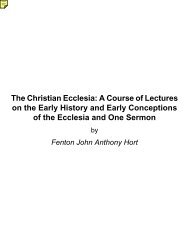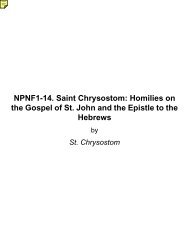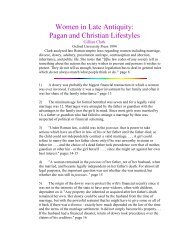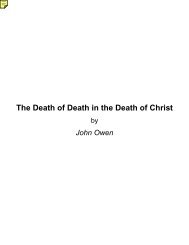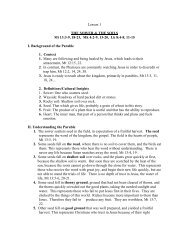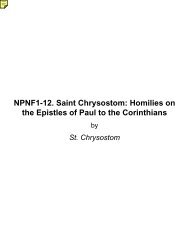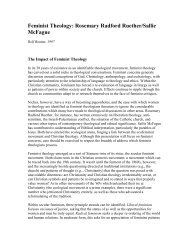Assisted Suicide and the Supreme Court
Assisted Suicide and the Supreme Court
Assisted Suicide and the Supreme Court
You also want an ePaper? Increase the reach of your titles
YUMPU automatically turns print PDFs into web optimized ePapers that Google loves.
<strong>Assisted</strong> <strong>Suicide</strong> <strong>and</strong> <strong>the</strong> <strong>Supreme</strong> <strong>Court</strong>David B. Fletcher, Ph.D.Department of Philosophy <strong>and</strong> CACE Steering CommitteeJanuary 17, 2006Should it be legal for a physician to help a patient end her own life at her request? Thisquestion has been asked in private conversations, hospital rooms, legislative chambers,<strong>and</strong> courthouses, particularly since Dr. Kevorkian brought it to public attention in <strong>the</strong>early 1990s. Although Dr. Kevorkian now sits in a Michigan prison cell for aiding in <strong>the</strong>televised death of a patient on CBS television’s 60 Minutes, <strong>the</strong> issues he raised grow inintensity. In 1997, <strong>the</strong> United States <strong>Supreme</strong> <strong>Court</strong> was asked to rule on whe<strong>the</strong>r <strong>the</strong>reis a constitutional right to physician-assisted suicide. They heard appeals of two cases,Compassion in Dying v. State of Washington, <strong>and</strong> Quill v. Vacco. The <strong>Court</strong> rejected <strong>the</strong>argument that <strong>the</strong> liberty guaranteed by <strong>the</strong> Constitution covers <strong>the</strong> right to commitsuicide with a doctor’s help. Although assisted suicide is not a constitutional right,nei<strong>the</strong>r is it clearly ruled out by <strong>the</strong> Constitution, <strong>the</strong>y concluded, <strong>and</strong> it would be up to<strong>the</strong> states to debate <strong>the</strong>se issues <strong>and</strong> make <strong>the</strong>ir own regulations.At that time, one state had already had this debate <strong>and</strong> had crafted a law permittinglimited physician assisted suicide, <strong>and</strong> today it remains <strong>the</strong> only state to have done so. In1994, Oregon legalized physician-assisted suicide, <strong>and</strong> by <strong>the</strong> end of 2004, over 208people had ended <strong>the</strong>ir lives this way. Under Oregon’s Death With Dignity Act, a patientmust be: 1) 18 years of age or older, 2) a resident of Oregon, 3) capable of making <strong>and</strong>communicating health care decisions for him/herself, <strong>and</strong> 4) diagnosed with a terminalillness that will lead to death within six months.
On January 17, 2006, <strong>the</strong> <strong>Supreme</strong> <strong>Court</strong> issued a ruling on a case that had <strong>the</strong> potentialof reversing <strong>the</strong> Oregon law. During President Bush’s first term, Attorney General JohnAshcroft had objected to a doctor’s use of legal drugs to end a life, <strong>and</strong> attempted touse federal drug control laws to prohibit Oregon’s physicians from assisting in <strong>the</strong>suicides approved by Oregon’s voters. He claimed that using drugs in this way did notserve a "legitimate medical purpose" <strong>and</strong> threatened to remove from offending doctors<strong>the</strong> right to prescribe drugs of any type, <strong>the</strong>reby putting an end to <strong>the</strong>ir medical careers.In defense of <strong>the</strong>ir law, Oregon officials <strong>and</strong> physicians sought to block <strong>the</strong>implementation of <strong>the</strong>se federal restrictions.The <strong>Court</strong>’s 6-3 majority, in a decision written by Justice Anthony Kennedy, ruled thatAshcroft had exceeded <strong>the</strong> authority delegated by Congress to combat drug traffickingwhen he attempted to apply those laws to <strong>the</strong> practice of medicine. It is for <strong>the</strong> states,not <strong>the</strong> federal government, to regulate <strong>the</strong> practice of medicine. This is in keeping with<strong>the</strong>ir earlier decision to allow <strong>the</strong>se matters to be regulated by <strong>the</strong> states. In his firstsignificant decision, Chief Justice John Roberts Jr. voted with <strong>the</strong> minority against <strong>the</strong>Oregon practice.Where does this leave American society on <strong>the</strong> issue of physician assisted suicide? Thisruling has to do with <strong>the</strong> Attorney General’s power to regulate <strong>the</strong> practice ofmedicine, <strong>and</strong> is not directly an endorsement of physician assisted suicide, yet <strong>the</strong> effectis to permit <strong>the</strong> taking of innocent human life. Legislative options remain, as Congresscould outlaw physician assisted suicide or <strong>the</strong> use of legal medications to assist in <strong>the</strong>se
deaths.How likely is this? Currently, it might be politically risky to push strongly to curbphysician assisted suicide, because American opinion has shifted strongly in favor of suchpractices, although <strong>the</strong>re remains a vigorous minority who oppose <strong>the</strong>m. Although in1950 only 26% of Americans agreed that doctors should be able to end patients’ lives incertain circumstances, today 72% agree, according to Gallup polls. A 2001 Harris pollfinds that 65% of Americans believe assisted suicide should be legal, <strong>and</strong> a Time magazinepoll found that 59% of Americans agreed strongly or somewhat with <strong>the</strong> decision todiscontinue <strong>the</strong> life prolonging feeding of Terri Schiavo.It is crucial to remember that <strong>the</strong> Christian ethical tradition has clearly <strong>and</strong> consistentlyrejected euthanasia <strong>and</strong> physician assisted suicide, <strong>and</strong> most Christian ethicists continueto firmly st<strong>and</strong> against <strong>the</strong>se practices. The biblical material that seems most relevant to<strong>the</strong>se topics is <strong>the</strong> comm<strong>and</strong> to do no murder. Christian tradition has overwhelminglyrejected hastening <strong>the</strong> death of those who are ill or dying. To take one example, BishopJeremy Taylor’s seventeenth century work, Holy Dying was meant to be a guide to help<strong>the</strong> Christian to prepare for death. Taylor discussed <strong>the</strong> comm<strong>and</strong>ment, Thou shalt dono murder <strong>and</strong> found its duties to include1.To preserve our own lives, <strong>the</strong> lives of our relatives, <strong>and</strong> all with whom weconverse, (or who can need us, <strong>and</strong> we assist,) by prudent, reasonable, <strong>and</strong> warydefences, advocations, discoveries of snares, etc. 2. To preserve our health, <strong>and</strong><strong>the</strong> integrity of our bodies <strong>and</strong> minds, <strong>and</strong> of o<strong>the</strong>rs. 3. To preserve <strong>and</strong> followpeace with all men.
The comm<strong>and</strong>ment is violated, says Bishop Taylor, by practicing suicide <strong>and</strong> euthanasia:“They sin against this comm<strong>and</strong>ment… that willingly hasten <strong>the</strong>ir own or o<strong>the</strong>rsdeath. ”1In a recent ecumenical statement issued jointly by <strong>the</strong> Church of Engl<strong>and</strong> <strong>and</strong> <strong>the</strong> RomanCatholic Church to <strong>the</strong> British House of Lords, <strong>the</strong> churches expressed centuries oldteaching when <strong>the</strong>y claimedBecause human life is a gift from God to be preserved <strong>and</strong> cherished, <strong>the</strong>deliberate taking of human life is prohibited except in self-defence or <strong>the</strong>legitimate defence of o<strong>the</strong>rs. Therefore, both Churches are resolutely opposedto <strong>the</strong> legalization of euthanasia even though it may be put forward as a means ofrelieving suffering, shortening <strong>the</strong> anguish of families or friends, or saving scarceresources.Fur<strong>the</strong>r, <strong>the</strong>y argue that “deliberately to kill a dying person would be to reject <strong>the</strong>m.”They go on to affirm thatOur duty is to be with <strong>the</strong>m, to offer appropriate physical, emotional <strong>and</strong>spiritual help in <strong>the</strong>ir anxiety <strong>and</strong> depression, <strong>and</strong> to communicate through ourpresence <strong>and</strong> care that <strong>the</strong>y are supported by <strong>the</strong>ir fellow human beings <strong>and</strong> <strong>the</strong>divine presence.The biggest challenge to a Biblical perspective on death <strong>and</strong> dying is not <strong>the</strong> courts, but<strong>the</strong> hearts of our fellow citizens. Unless <strong>the</strong> value <strong>and</strong> dignity of human life at all stages1 11 Jeremy Taylor, Holy Living <strong>and</strong> Holy Dying, 2 vols., ed. P. G. Stanwood (London: Clarendon Press, 1985)
is upheld, laws will inevitably follow opening <strong>the</strong> doors to fur<strong>the</strong>r killing of <strong>the</strong> sick <strong>and</strong>dying. The alternative, to progressively open <strong>the</strong> doors to voluntary active euthanasia,will lead us down <strong>the</strong> sad path taken by <strong>the</strong> Ne<strong>the</strong>rl<strong>and</strong>s. Dutch physician RichardFenigsen has written that Dutch general practitioners are estimated to perform from5000 to 20,000 cases per year, which he notes that in American terms would be from80,000 to 300,000 cases per year. 2 In his research he has found “involuntaryeuthanasia…is rampant.” He found that “a staggering 62% of all newborns' <strong>and</strong> infants'deaths resulted from ‘medical decisions,’" <strong>and</strong> that in 1995 alone <strong>the</strong>re were 900 lethalinjections given to patients who had not requested euthanasia. 3 Among that group, 189were fully competent <strong>and</strong> could have been consulted about <strong>the</strong>ir consent but were not.He concludes that “those who contend that it is possible to accept <strong>and</strong> practice "voluntary" euthanasia <strong>and</strong> not allow involuntary totally disregard <strong>the</strong> Dutch reality.”There is little reason to hope that <strong>the</strong> killing of patients in this country will remainvoluntary, nor that our sick will be able to count on compassionate care ra<strong>the</strong>r than ahasty death, unless voices are raised against physician assisted suicide.2 “A Case Against Dutch Euthanasia,” Hastings Center Report special supplement, Jan/Feb, 1989.3 Richard Fenigsen, “Dutch euthanasia revisited, “ Issues in Law & Medicine, Winter 1997 v13 n3 p301-311




